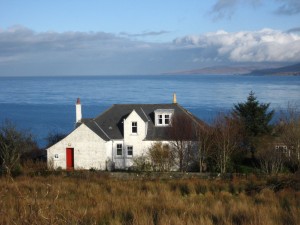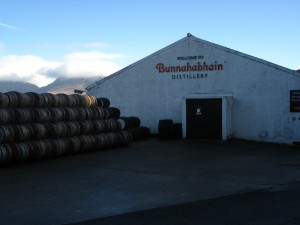A few days ago, I took a four mile walk from my cottage on Persabus Farm to the end of the coastal road on Islay’s northeastern shore. The weather was unbeatable – no rain to soak me, no wind to knock me about and plenty of sunshine to give me stunning views of Jura’s snow-covered mountains and to bring out the brilliant blue of the North Sea.
Along the solitary way, I was only passed by a fishing boat, heading out for the afternoon’s catch. The boat slipped out of sight as my destination came into view: Bunnahabhain Distillery. The visual transition was most appropriate, as Distillery Manager John MacLellan gave up a career as a fisherman and a life on the water to work in the world of whisky making the water of life.
Bunnahabhain is the Islay distillery I am least familiar with, so it made for an appropriate first stop. The distillery is nestled in a little cove along the Sound of Islay, within shouting distance of the Isle of Jura on the other side. If you jumped on a raft at the distillery’s dock and let the current take you, I don’t think you’d stop until you hit Santa’s icy beach – it’s just open water as far as the eye can see once you are through the sound. The place is quiet, secluded and large – Bunnahabhain produced more than two million liters last year – but still intimate.
I’d only had a couple of tastes of Bunnahabhain through the years – their standard 12-year-old and an independent bottling that was around 32-years old. What I remembered from both was how faintly peated the malt was. This is significant because Islay’s malts are known for being at the peak of single malt peatiness.
John told me the faint peatiness is intentional. Bunnahabhain has served for many years as a primary malt in the Black Bottle blend, and as such is distilled to complement that blend and others (Cutty Sark, Famous Grouse), rather than stand out as a single malt. It wasn’t until 1979 (the distillery was founded in 1881) that Bunnahabhain’s 12-year-old came on the market as a single malt. In the past few years, they’ve added 18-year-old and 25-year-old bottlings.
With only a 2ppm phenol count, the light peatiness allows Bunnahabhain to use primarily sherry casks in aging. The spirit itself has the fruity flavor of apples and a citrus tinge of lime that seems drawn through cereal. The result is a light, fruity flavor that has hints of grain, peat and is frosted with sherry nuttiness. The sherry influence is richer in the older bottlings, in part due to more years spent in the cask, but also due to the inclusion of more first-fill sherry casks in older bottlings.
MacLellan says the key to Bunnahabhain are the water, which is collected at the source in order to reduce the chance for the natural peatiness of Islay’s soil to infiltrate the water, and the mash cycle of the grain. The distillery uses a significantly longer than typical mash cycle to maximize spirit yield from each batch of barley. The longer cycle helps maintain spirit quality even when the quality of the grain is lesser due to a poor growing season.
Bunnahabhain was the first Islay distillery to make a special bottling for Islay’s hugely popular yearly whisky festival, and each bottle is signed by MacLellan and at least one other member of the 11 person workforce. Fans that purchase the autographed bottles are getting a real prize of whisky-making history. MacLellan has more than 30 years in the industry, and several other staffers have up to 40 years experience, mainly at Bunnahabhain. It’s this consistency that is the hearth fire fueling the fine malt.
I was quite surprised by Bunnahabhain and their bottlings. The 12-year-old is a great any time dram, and the 18-year-old is a wonderful winter drink or end of the day tipple. In my minimal previous exposure, the malt didn’t make an impression one way or another. Now that I’ve taken a serious look at the distillery and truly earned a taste (four miles walk for a dram!), I find Bunnahabhain is an unexpected delight. It’s a nice bridge between Islay and the mainland malts. Enjoy it if you get the chance! www.bunnahabhain.com



Bunnahabhain is actually one of my favorites and the 18 yr old bottle is what I served at the head table in my wedding. I hope to make it over to their distillery this year. Thanks for the wonderful update. It is always a pleasure to read.